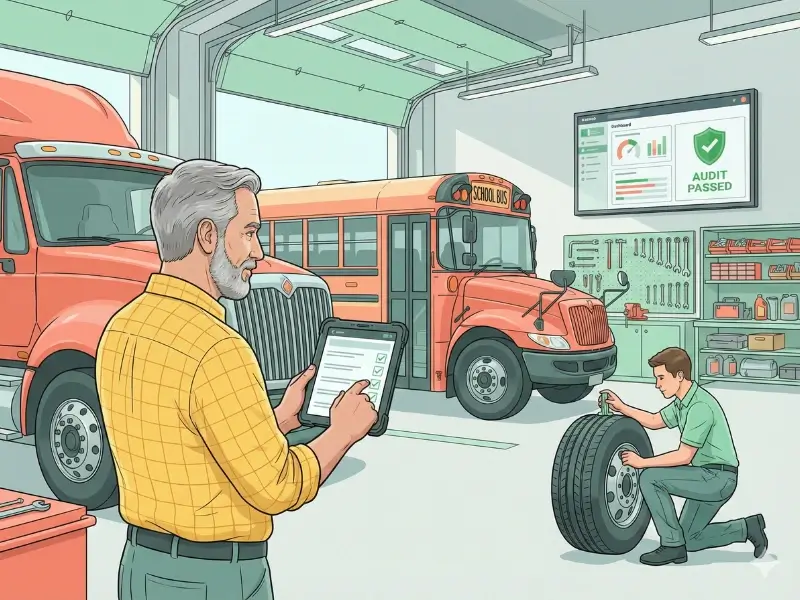Key Takeaways
In order to ensure safe and efficient transportation on our roads, it is crucial for companies and organizations within the transportation industry to adhere to the guidelines set forth by the Department of Transportation (DOT). To achieve this, regular audits and checks for DOT compliance are of utmost importance. Understanding DOT compliance, the role of regular audits, the significance of regular checks, consequences of non-compliance, and strategies for maintaining DOT compliance are all key aspects that will be explored in this article.
Understanding DOT Compliance
DOT compliance refers to the adherence to rules and regulations set by the Department of Transportation to ensure safety in the transportation industry. These regulations apply to various modes of transportation, including highways, railways, airways, and waterways.
Compliance with DOT regulations is not only a legal requirement, but it also helps in maintaining a safe working environment and reducing the risk of accidents. It is crucial for transportation companies to have a clear understanding of DOT compliance guidelines.
Definition of DOT Compliance
DOT compliance encompasses the rules and regulations that govern the operation and maintenance of vehicles and equipment used in transportation. This includes driver qualifications, vehicle inspections, drug and alcohol testing, hours of service regulations, and record keeping.
Key Elements of DOT Compliance
There are several key elements that make up DOT compliance:
- Driver Qualifications: Ensuring that drivers meet the necessary qualifications, including age, licensing, and medical examinations, is essential for DOT compliance.
- Vehicle Inspections: Regular inspections of vehicles and equipment help identify any potential safety risks or issues that need to be addressed.
- Drug and Alcohol Testing: DOT regulations require regular drug and alcohol testing for safety-sensitive employees to ensure a drug-free work environment.
- Hours of Service Regulations: These regulations dictate the maximum amount of time a driver can spend on the road and the required rest periods to prevent driver fatigue.
- Record Keeping: Proper record keeping is crucial for successfully demonstrating compliance with DOT regulations. This includes maintaining documentation related to driver qualifications, vehicle maintenance, and hours of service.
Driver qualifications are a critical aspect of DOT compliance. It is essential for transportation companies to ensure that their drivers possess the necessary qualifications to operate commercial vehicles safely. This includes verifying that drivers have the appropriate age, licensing, and medical examinations required by the DOT. By adhering to these driver qualification requirements, companies can help reduce the risk of accidents and ensure the safety of their drivers and the public.
Vehicle inspections play a vital role in maintaining DOT compliance. Regular inspections help identify any potential safety risks or issues with vehicles and equipment that need to be addressed. These inspections can help prevent accidents caused by faulty equipment or mechanical failures. By conducting thorough and regular inspections, transportation companies can ensure that their vehicles are in proper working condition and comply with DOT regulations.
The Role of Regular Audits in DOT Compliance
Regular audits play a vital role in ensuring DOT compliance within transportation companies. These audits help identify areas of non-compliance and allow for corrective actions to be taken before they result in serious consequences.
Furthermore, regular audits not only help in maintaining compliance but also contribute to enhancing overall operational efficiency. By reviewing and evaluating processes, documentation, and training programs, transportation companies can identify opportunities for streamlining operations, reducing costs, and improving service quality.
Another key benefit of regular audits is the enhancement of safety standards within transportation companies. By identifying and addressing non-compliance issues promptly, audits help in creating a safer work environment for employees and reducing the risk of accidents on the road.
Purpose of Regular Audits
The primary purpose of regular audits is to assess the level of compliance with DOT regulations within an organization. Audits help uncover any deficiencies or gaps in processes, policies, or training that may lead to non-compliance. By conducting audits on a regular basis, companies can proactively address these issues and mitigate the risk of accidents, penalties, and legal consequences.
Frequency of Audits
The frequency of audits may vary based on the size and nature of the transportation company. It is recommended that audits be conducted at least once a year, or more frequently if the company has a high volume of operations or a history of non-compliance. Regular audits help ensure continuous improvement and the maintenance of DOT compliance.
In addition to annual audits, transportation companies are encouraged to conduct random spot checks throughout the year to ensure ongoing compliance with DOT regulations. These spot checks can help in identifying any emerging issues or trends that require immediate attention, thereby strengthening the company's overall compliance posture.
The Significance of Regular Checks
In addition to audits, regular checks are crucial for maintaining DOT compliance. These checks focus on routine inspections and monitoring to identify any potential issues or deviations from compliance.
Regular checks are an integral part of a company's commitment to upholding safety standards and regulatory requirements. By conducting these checks on a consistent basis, organizations demonstrate their dedication to ensuring the well-being of their drivers, vehicles, and the public. It is through these regular evaluations that companies can proactively address any compliance issues before they escalate into larger problems.
The Process of Regular Checks
Regular checks involve ongoing monitoring and inspection of key areas, such as vehicle maintenance records, driver logs, and drug and alcohol testing records. Companies must establish protocols and allocate resources to conduct these checks consistently and effectively.
Furthermore, the process of regular checks extends beyond mere compliance monitoring. It serves as an opportunity for companies to evaluate the effectiveness of their current practices and identify areas for improvement. By analyzing the data collected during these checks, organizations can implement targeted training programs or adjust policies to enhance overall compliance and operational efficiency.
Benefits of Regular Checks
The benefits of regular checks are manifold. Firstly, they help identify any non-compliance issues that may have gone unnoticed during audits. Secondly, regular checks serve as a preventive measure by maintaining a constant focus on compliance. They contribute to the overall safety and efficiency of operations by ensuring that vehicles are properly maintained, drivers are following regulations, and records are up to date.
Moreover, the data gathered from regular checks can be used to track trends over time, allowing companies to spot recurring issues and implement long-term solutions. This proactive approach not only minimizes the risk of non-compliance penalties but also fosters a culture of continuous improvement within the organization. Ultimately, regular checks play a vital role in safeguarding the reputation and integrity of a company within the transportation industry.
Consequences of Non-Compliance
Non-compliance with DOT regulations can lead to severe consequences for transportation companies. It is vital to understand the potential legal and financial impacts of failing to comply with DOT requirements.
Ensuring compliance with Department of Transportation (DOT) regulations is crucial for transportation companies to operate safely and efficiently. Failure to adhere to these regulations can have far-reaching consequences that extend beyond just financial penalties.
Transportation companies must not only comply with DOT regulations but also stay updated on any changes or updates to these rules. Regular training and education for employees on compliance protocols can help mitigate the risks associated with non-compliance.
Legal Implications of Non-Compliance
Non-compliance with DOT regulations can result in fines, penalties, and even the suspension or revocation of operating licenses. Serious violations may also lead to criminal charges, further jeopardizing the reputation and business continuity of the company.
Legal implications of non-compliance can also involve increased scrutiny from regulatory bodies, leading to audits and investigations that can disrupt normal business operations. It is essential for transportation companies to have robust compliance programs in place to avoid such legal repercussions.
Financial Impact of Non-Compliance
The financial impact of non-compliance can be significant. In addition to fines and penalties, non-compliant companies may face increased insurance premiums, legal expenses, and damage to their reputation. Moreover, accidents resulting from non-compliance can lead to costly lawsuits and settlements.
Financial repercussions of non-compliance can extend to loss of business opportunities and contracts as potential partners and clients may be hesitant to engage with companies with a history of regulatory violations. Maintaining a strong compliance record is not just a legal requirement but also a strategic business imperative in the transportation industry.
Strategies for Maintaining DOT Compliance
Adherence to DOT compliance requires a proactive and comprehensive approach within transportation organizations. Implementing a compliance program and providing training and education are key strategies for maintaining DOT compliance.
Implementing a Compliance Program
A compliance program lays the foundation for maintaining DOT compliance. This program should include clear policies and procedures, employee training, regular audits and checks, and a system for addressing non-compliance issues promptly. It is crucial that the program is tailored to the specific needs and requirements of the organization.
For instance, a compliance program may involve the creation of a dedicated compliance team within the organization. This team would be responsible for overseeing the implementation and enforcement of DOT regulations. They would work closely with management and employees to ensure that all policies and procedures are followed diligently.
In addition, the compliance program may also include the establishment of a hotline or reporting mechanism for employees to report any potential violations or concerns. This encourages a culture of transparency and accountability within the organization, as employees feel empowered to speak up and address any compliance issues.
Training and Education for Compliance
Proper training and education are vital to ensure that employees have a thorough understanding of DOT regulations. Training should cover driver qualifications, vehicle maintenance, hours of service regulations, drug and alcohol testing, and record keeping. Ongoing education and updates are essential to keep employees informed about any changes in DOT compliance requirements.
One effective training method is the use of interactive workshops and seminars. These sessions provide employees with the opportunity to engage in hands-on learning and ask questions in real-time. They also allow for the sharing of best practices and experiences among employees, fostering a collaborative learning environment.
Furthermore, organizations can leverage technology to enhance training and education efforts. Online training modules and e-learning platforms can be utilized to deliver consistent and standardized training materials to employees across different locations. This ensures that all employees receive the same level of training and knowledge, regardless of their geographical location.
By investing in comprehensive training and education programs, organizations can equip their employees with the necessary knowledge and skills to navigate the complexities of DOT compliance.
In conclusion, implementing a compliance program and providing training and education are crucial strategies for maintaining DOT compliance within transportation organizations. By establishing clear policies and procedures, conducting regular audits, and providing ongoing training, organizations can ensure the safety and efficiency of their transportation operations. With a proactive approach to DOT compliance, organizations can mitigate risks, avoid legal and financial consequences, and uphold the highest standards of safety and compliance.
Streamline Your Fleet Compliance with Simply Fleet
Ready to take the complexity out of DOT compliance for your fleet? Simply Fleet offers a comprehensive fleet maintenance solution that streamlines your day-to-day operations. With features like preventive maintenance reminders, digital vehicle inspections, repair work orders, and detailed logs for fuel, expenses, and service history, managing your fleet has never been easier. Our platform provides you with consolidated data analytics to enhance decision-making and boost uptime while saving costs. Don't wait to optimize your fleet's compliance and efficiency. Get Started with Simply Fleet today and drive your fleet towards success.



.png)








.png)


.png)






.webp)



